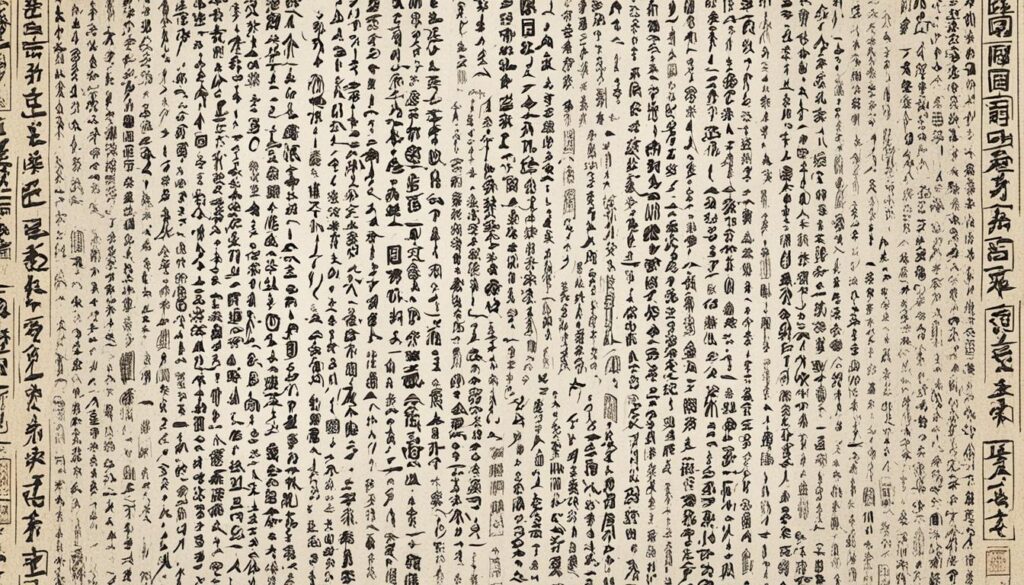The ancient Chinese script, known for its character complexity and logographic writing system, boasts an impressive history that spans thousands of years. One of the earliest forms of this script can be found in Chinese bronze inscriptions, which date back to the Shang dynasty (2nd millennium BC) and continued through the Zhou dynasty (11th–3rd century BC). These inscriptions, often featuring clan or personal names, provide a fascinating glimpse into the evolution of Chinese characters and their influence on East Asian culture.
The bronze inscriptions from the late Shang to early Zhou periods were highly pictographic, with the writing system laying the foundation for the development of Chinese characters. As time passed, the inscriptions grew in length, from just a few characters in the early Shang examples to around 500 characters in some Zhou dynasty bronzes. This growth in complexity and length showcases the increasing sophistication of the ancient Chinese script and its ability to convey more complex ideas and concepts.
Key Takeaways
- Ancient Chinese script had over 6,000 characters, showcasing its complexity and logographic nature.
- Chinese bronze inscriptions, dating back to the Shang and Zhou dynasties, are among the earliest forms of Chinese writing.
- The inscriptions evolved from highly pictographic to more complex, with lengths increasing from a few characters to around 500.
- The writing system used in these inscriptions laid the foundation for the development of Chinese characters and their influence on East Asian culture.
- The growth in complexity and length of the inscriptions demonstrates the increasing sophistication of the ancient Chinese script.
The Evolution of Chinese Bronze Inscriptions
The Shang dynasty marked a significant period in the development of Chinese bronze inscriptions. These inscriptions were primarily used to identify clan names or commemorate ancestors and were typically short and simple in nature. The process of creating these inscriptions involved bronze casting using wet clay molds, resulting in highly pictographic characters that could be written facing various directions without altering their meaning.
The complex and pictographic style of Shang bronze inscriptions suggests that they were a formal script, comparable to the writing used on bamboo or wood books during the same era. As the Western Zhou dynasty emerged, bronze inscriptions continued to evolve, initially closely resembling the Shang bronze script. However, over time, the Western Zhou period witnessed a gradual character simplification and linearization process.
This evolution saw the rounding of elements into squared shapes, the transformation of solid elements into short line segments, and the standardization of line widths. As a result, the pictographic quality of the characters decreased. The term “large seal script” is occasionally used to describe the script of this period, although its definition can be inconsistent and problematic.
Ancient Chinese Script Complexity
The complexity of ancient Chinese scripts is best exemplified by the writing system developed by the Xi-Xia kingdom, which existed from 1038 to 1227. This kingdom created a script that contained approximately 6,000 individual characters, a number that closely mirrors the number of Chinese characters used by the Han Chinese today. This suggests that the range of 6,000-7,000 characters may represent the natural limit of human memory when it comes to logographic writing systems.
The intricacy and diversity of ancient Chinese scripts, as seen in the bronze inscriptions and the scripts used by various kingdoms and nationalities, highlight the rich cultural heritage and linguistic diversity that characterized East Asian culture. The fact that Chinese characters have survived throughout history, despite the rise and fall of numerous dynasties and kingdoms, is a testament to the strong cultural background and influence of the Han Chinese civilization.

The complexity of the Chinese writing system is further underscored by the fact that it is not an alphabetic script, but rather a logographic one. Each character represents a word or a morpheme, which means that the number of characters required to express a wide range of ideas and concepts is significantly higher than in alphabetic writing systems. This complexity has both advantages and disadvantages. On one hand, it allows for a greater depth of meaning and nuance in written communication. On the other hand, it requires a significant investment of time and effort to master the thousands of characters necessary for literacy.
Despite the challenges posed by the complexity of the Chinese writing system, it has endured for thousands of years and continues to be an integral part of East Asian culture. The ability of the Chinese script to adapt and evolve over time, incorporating new characters and styles while maintaining its core structure, is a testament to its resilience and cultural significance.
The Family of Character-Type Scripts
The Chinese writing system has had a profound impact on the linguistic diversity of East Asia, giving rise to a rich family of character-type scripts used by various peoples and nationalities. This family of scripts has undergone four distinct stages of development: transplantation, naturalization, imitation, and creation. During the imitation stage, new scripts were created through two main processes: propagation, which involved using original components of Chinese characters to form new ones, and differentiation, which adopted the principles but not the appearance of Chinese characters.
Scripts created through imitation by propagation include Zhuang, Nam, Miao, Yao, Buyi, Dong, Bai, and Hani characters. These scripts borrowed and adapted elements from Chinese characters to represent their own languages. On the other hand, scripts created through imitation by differentiation, such as the major characters of Qidan, Nyuzhen, Xi-Xia, and Shui scripts, followed the structural principles of Chinese characters but developed their own unique forms.
The creation stage saw the development of character-type alphabets, both syllabic alphabets and phonemic alphabets. Japanese Kana and Yi characters are notable examples of this stage, demonstrating how the Chinese writing system inspired the creation of new scripts that better suited the phonetic and grammatical structures of other languages. The diverse family of character-type scripts that emerged from the influence of the Chinese writing system showcases the incredible linguistic diversity and cultural richness of East Asia.

Leave a Reply